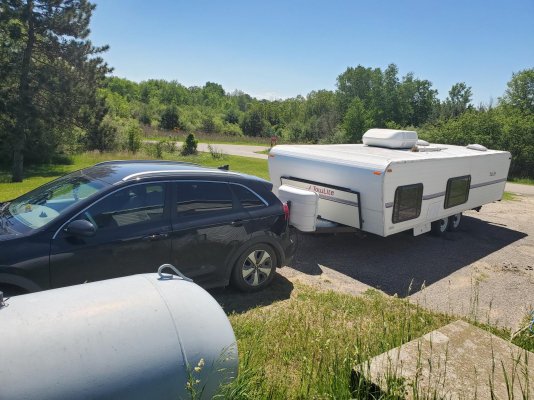Just picked up a 96 towlite from a small dealer nearby this weekend! $4000 cash. Tested it out by camping overnight in the inlaw's driveway before going home. Pretty much everything worked great. The only things I found is the top isn't level so I can't open the outdoor sprayer door, and the water heater pilot is building up crazy soot. Both of which I'll try to fix this week.
My kia niro doesn't do too bad towing it. I got about 2 inches of rear axle drop, but I'm getting airbags installed this week for that. The hitch mount manufacturer says the hitch isn't built for adding a balanced hitch, but it's not too bad. I still have to get to a scale to weigh the tongue weight. Braking with the Curt Echo wireless brake controller worked great, don't even feel the trailer there. Plus I have 40 horsepower of regenerative braking before the physical brakes even engage.
The engine is only under moderate load pulling it at 50-55mph in fifth gear (out of six) on level ground. When cruising though the hybrid battery drains and it's pulling entirely on engine power, but as soon as I slow down the engine fills it back up to give me me plenty of extra oomph to accelerate up any hill I encountered. My mpg dropped from 45 to 24-30, which makes sense since its running only on engine power. No temperature rise, and it's got an electrically actuated manual transmission, so I don't have to worry about that like if I had an automatic.
Overall everything is working as well as I was expecting. I'm planning on a good fraction of usage bieng boondocking and walmart camping, so I'll have to see how everything goes when running using my car's 2kW inverter.
My kia niro doesn't do too bad towing it. I got about 2 inches of rear axle drop, but I'm getting airbags installed this week for that. The hitch mount manufacturer says the hitch isn't built for adding a balanced hitch, but it's not too bad. I still have to get to a scale to weigh the tongue weight. Braking with the Curt Echo wireless brake controller worked great, don't even feel the trailer there. Plus I have 40 horsepower of regenerative braking before the physical brakes even engage.
The engine is only under moderate load pulling it at 50-55mph in fifth gear (out of six) on level ground. When cruising though the hybrid battery drains and it's pulling entirely on engine power, but as soon as I slow down the engine fills it back up to give me me plenty of extra oomph to accelerate up any hill I encountered. My mpg dropped from 45 to 24-30, which makes sense since its running only on engine power. No temperature rise, and it's got an electrically actuated manual transmission, so I don't have to worry about that like if I had an automatic.
Overall everything is working as well as I was expecting. I'm planning on a good fraction of usage bieng boondocking and walmart camping, so I'll have to see how everything goes when running using my car's 2kW inverter.


